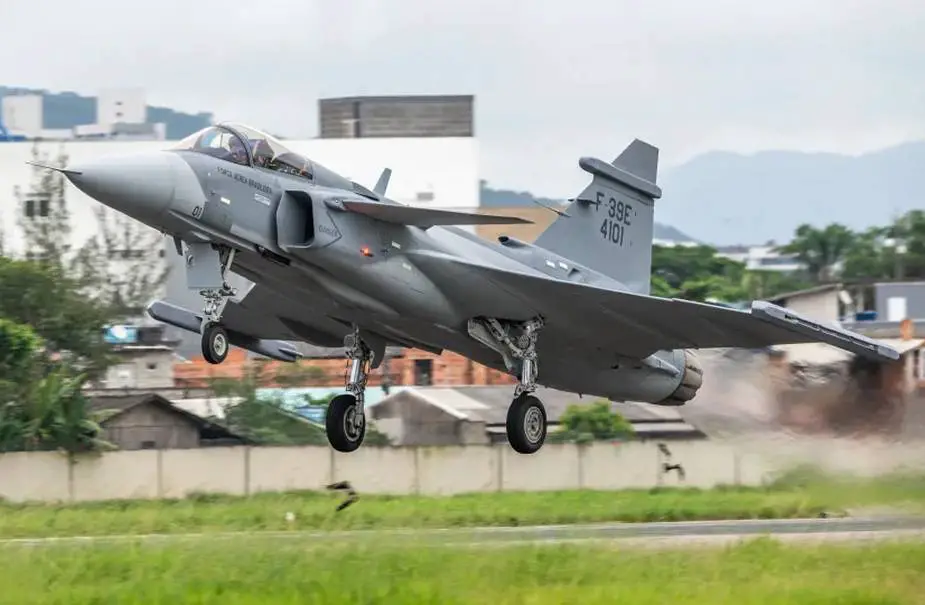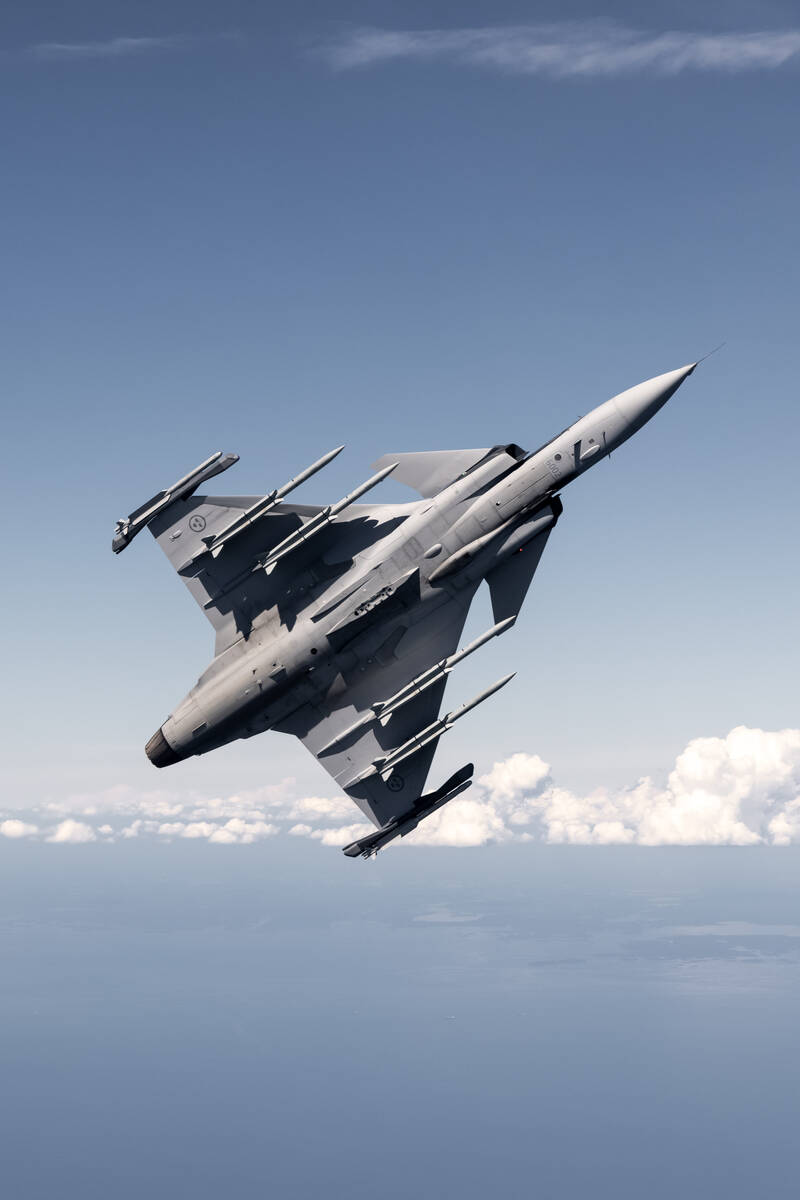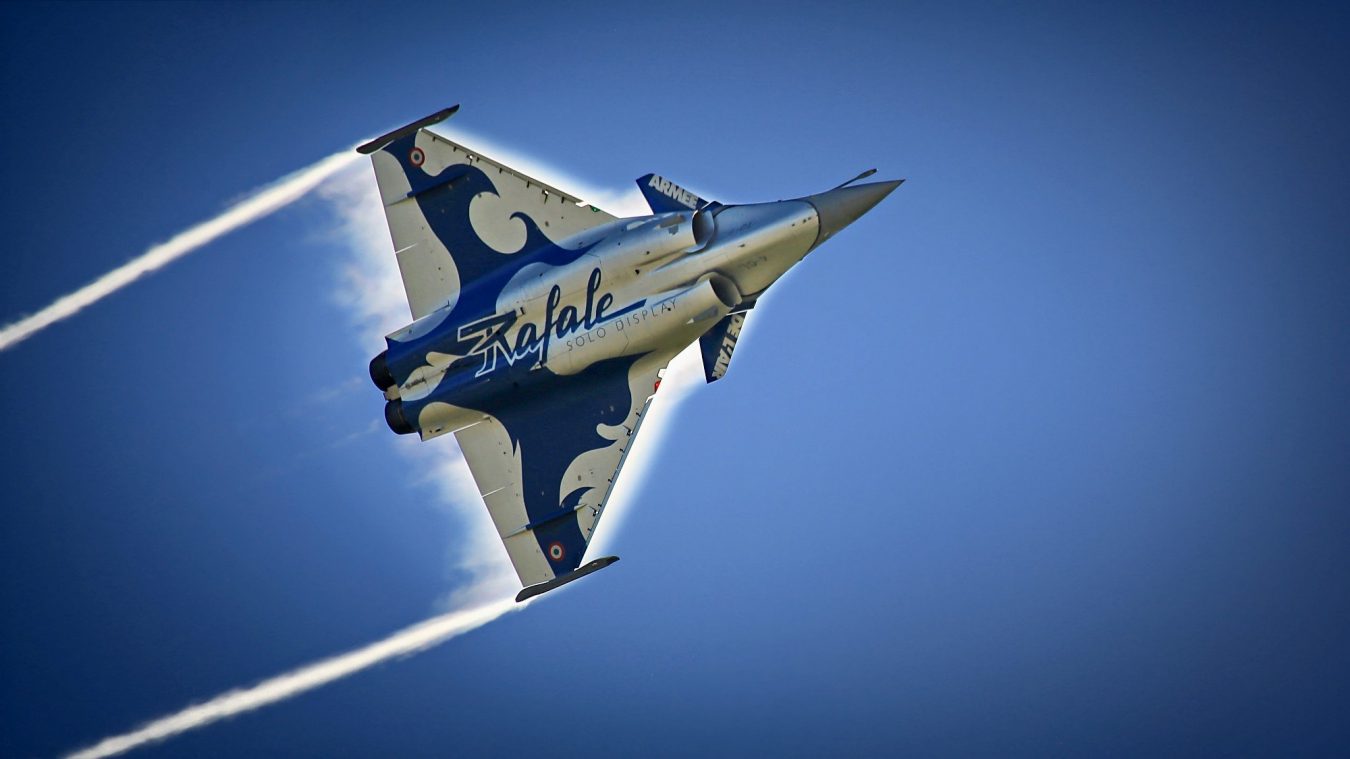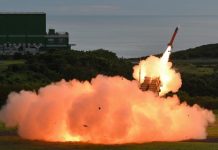The Brazilian Air Force (FAB) held a ceremony on December 19 at the Anápolis Air Base (BAAN) to mark the beginning of operational activities of the Gripen E fighters, referred to as Gripen F-39 in Brazil, with the 1st Aviation Group of FAB.
During the event, two F-39 fighters made a demonstration flight that was witnessed by military and defense industry representatives.
The Brazilian Air Force commander, Lt. Brig. Carlos de Almeida Baptista Júnior, said during the ceremony that the start of operations of the Gripen is “a milestone” for its service, emphasizing that these fighters will provide “operational capabilities that Brazil never had.”
“The start of operational activities with Gripen E by the Brazilian Air Force (FAB) is an extremely important day,” Saab president Micael Johansson said in a press release. “It marks the beginning of a new operational era for FAB but also is the result of years of hard work done in partnership with the air force and with our Brazilian industry partners.”

The first F-39E jet in Flight Test Instrumentation (FTI) configuration arrived in Brazil in September 2020 for flight and ground tests. Brazil received four new serial productions, F-39 E fighters, between April and September this year.
Saab had won a contract with Brazil in 2014 for 36 Gripen E/F aircraft after a tough competition that included the Dassault Rafale, Boeing’s F/A-18 Super Hornet, and the Eurofighter Typhoon.
The contract worth US$ 4.02 billion required Saab to provide 28 F-39E single-seaters and 8 F-39F twin-seaters for Brazil’s F-X2 Fighter Modernization Program.
Saab JAS 39 Gripen E/F Multirole Fighter Aircraft
The Saab Gripen E is an upgraded version of the Gripen C/D multi-role aircraft. Gripen C/D was developed in the late 1990s as an upgrade to the earlier A/B variants, while the E/F variants were developed in the 2010s to enhance all aspects of earlier models.
Saab says, “The E-series redefines airpower for the 21st century by extending operational capabilities.”
The Gripen E features a new General Electric F414 turbofan engine, an upgraded airframe, new avionics, and an electronic warfare suite, among other things.

The latest E-series fighter has a maximum payload capacity of 16,500 kg and a speed of Mach 2. It is equipped with a new AESA-radar, InfraRed Search and Track System (IRST), to track threats at longer ranges.
Also, the Gripen E features what Saab refers to as Human-Machine Collaboration (HMC) which is a combination of Human-Machine Interface (HMI) and tactical systems that offer only the relevant information to the pilot by filtering all other overly technical and incomprehensible information, thereby allowing the pilot to save time and act almost immediately in times of crisis.
Notably, Gripen was the first fighter to carry the deadly Meteor air-to-air missile (AAM), capable of tracking and destroying targets within a range of close to 130 kilometers.
While the Gripen’s C variant can carry four Meteor missiles, the E-series fighter can carry up to seven.
Apart from that, the Gripen-E’s air-to-air armament includes the infrared-guided short-range IRIS-T missile, the imaging infrared homing ASRAAM and Python series of short-range missiles, and long-range weapons such as R-Darter and Derby.

The aircraft can also be loaded with Sidewinder and Advanced Medium Range Air-to-Air Missile (AMRAAM) missiles.
Gripen-E can also carry several air-to-surface weapons, including unguided Mk82, Mk83, and Mk84 bombs, laser-guided bombs such as GBU-12, GBU-16, and GBU-10, and advanced bombs such as GBU-49 and GBU-39.
Among the air-to-surface missiles that Gripen E can carry include RBS15F ER, TAURUS KEPD 350, AGM-65 Maverick, and MBDA’s dual-mode Brimstone (DMB).
The aircraft also has a 27mm all-purpose Mauser BK27 high-velocity gun, providing both air-to-air and air-to-surface attack capability.
As for countermeasures, the Gripen-E is equipped with a missile approach warning (MAW) system, capable of carrying more chaff packets and flares compared with similar aircraft, enhancing its survivability.
However, what helped the Gripen-E to beat the competition from Dassault Rafale and Boeing’s F/A-18 Super Hornet for the Brazilian fighter contract, was its low operational and lifetime costs, plus Saab’s ability to offer a more significant level of technology transfer.
Saab had offered the Gripen at almost half the price of either Dassault’s Rafale or Boeing’s F/A-18.
As opposed to $4.02 billion for the Saab Gripen, Brazil reportedly had to spend about $8 billion for Dassault’s Rafale and $7.5 billion for Boeing’s F/A-18. Also, the cost per hour per flight for the Gripen is said to be $4,000, compared to the Rafale’s $14,000 and F/A-18’s $10-14,000.
Moreover, Saab had reportedly offered a more significant level of technology transfer for the fighter, as compared to Dassault and Boeing, which was an even more important factor that helped it clinch the deal.

Brazil had insisted on technology transfers so that the planes could be assembled locally and give a boost to the domestic defense industry, and therefore how much of the fighters’ technology the bidder is able and willing to share and how much of it will be built within its borders was a decisive factor in awarding the contract.
Brazil’s Air Force Commander at the time, Lt. Brigadier Juniti Saito, said that several Brazilian companies would contribute to the project while announcing the choice of Saab Gripen. Upon its completion, Brazil would have full access to the technology of the aircraft.
In 2018, Saab unveiled its new aerostructures facility in Brazil near Sao Paulo, known as the Saab Aeronáutica Montagens, with plans to incorporate up to 200 employees by 2024.
By 2020, the new manufacturing plant had employed more than 70 workers and begun producing the tail cone and front fuselage for the single-seat Gripen E version of the jet, with plans to eventually make the brakes, rear fuselage, wing box, and front fuselage for the two-seater “F” model.
Those structures would then undergo final assembly at Embraer’s nearby plant in Sao Paulo and Saab’s main Gripen production hub in Linköping, Sweden.
Brazil Plans To Buy More Gripens
There are plans to buy more Gripens to double the FAB’s current fleet of 36 Gripen aircraft. In February, Lt. Brig. Baptista Jr. said in an interview that there were on with Saab for buying an additional 30 Gripen fighter jets to reach a total of 66 fighter jets.
“Our capacity-based plans point to a total of 66 aircraft. How to get to that number is something that we are discussing; it is at an early stage. There is an intention,” Baptista Jr. said.
With 66 Gripen Es, Brazil will have the largest fighter jet fleet in the region, which according to experts, will impact how other South American countries modernize and reequip their combat aircraft fleets, thereby creating the possibility of more sales of Gripen.
- Contact the author at tanmaykadam700@gmail.com
- Follow EurAsian Times on Google News




